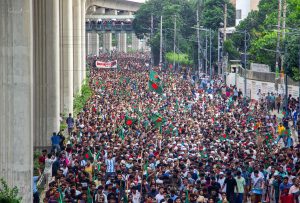One minute it looked like she was in full command of the fast-growing country over which she wielded “hard power,” as her November 2023 Time Magazine cover put it. Nine months later, she was fleeing Bangladesh ignominiously in a helicopter bound for India, after a popular uprising she had attempted to repress in a frenzy of armed violence killed and maimed thousands.
Days and even hours before she fled, close observers and political analysts were puzzling over the endgame: Was Hasina really planning to shoot her way out of the crisis? It seemed so. And despite the massive movement demanding her resignation, her power rested on such a robust coalition of state and political forces that close observers and political analysts alike could not imagine her giving up power.
How did Hasina fall so far, so fast?
The first and most critical answer is that demands for democracy after 15 years of increasingly autocratic rule could no longer be suppressed. Rigged elections, jailed opposition members, a sinister campaign of enforced disappearances, and the criminalization of dissent had shored up the Awami League’s power. “Hard power” came at a high cost to those targeted, but also to the legitimacy of the regime. Fear and anger could only be contained through extensive violence, both overt and hidden from the public view. The Students-People’s Uprising that came together over the summer of 2024 was not the first such movement: earlier student protests had been violently put down, but none had attracted the level of popular cross-class support of the Monsoon Uprising.
What was different this time? How did the student movement escalate beyond the point of no return when the Awami League had been able to contain earlier bouts of contention?
An increasingly evident part of the explanation is the failure of the development model on which Hasina had prided herself, and on which the regime’s legitimacy had rested. This interpretation counters the noisy narrative and visible markers of economic success that had long clouded and deflected scrutiny of the murky means through which growth was pursued in Bangladesh.
Why and how did Sheikh Hasina’s development dream turn into a bloody nightmare?

































